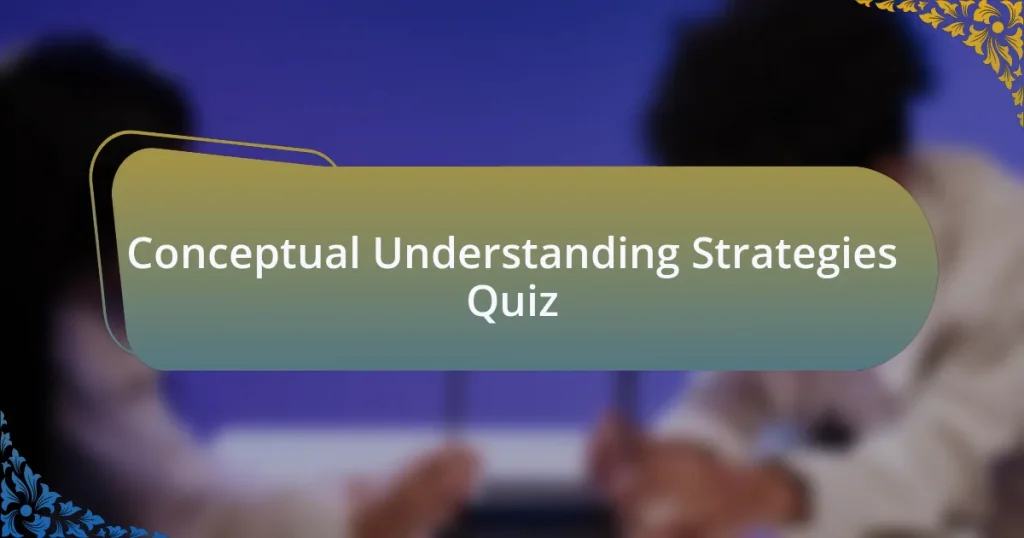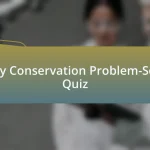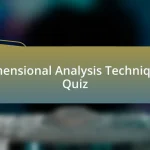Start of Conceptual Understanding Strategies Quiz
1. What is conceptual understanding in the context of physics education?
- Conceptual understanding refers to the ability to grasp and apply abstract concepts, making connections between them and real-world contexts.
- Conceptual understanding means understanding only through textbook definitions.
- Conceptual understanding is memorizing formulas and equations without comprehension.
- Conceptual understanding focuses only on solving numerical problems in isolation.
2. How do physics concept maps enhance students` understanding of complex topics?
- Concept maps confuse students by introducing unrelated topics.
- Concept maps help visualize relationships between complex ideas.
- Concept maps only serve as decorative tools in classrooms.
- Concept maps are primarily used for basic memorization of facts.
3. What activities can help students categorize physical concepts in physics?
- Watching physics videos
- Reading textbooks
- Concept sorting activities with real objects
- Memorizing definitions
4. How can reflection task cards improve students` comprehension of physics concepts?
- Reflection task cards only serve as assessment tools with no learning benefits.
- Reflection task cards encourage connections between learning and real-world applications.
- Reflection task cards distract students from critical thinking.
- Reflection task cards limit students` ability to think independently.
5. What methods can mime living diagrams be used to illustrate physics principles?
- To demonstrate abstract physics concepts through movement.
- To summarize textbook definitions in written form.
- To memorize formulas through repetition.
- To create static diagrams that represent basic equations.
6. How are concept journals utilized to track physics learning progress?
- Concept journals contain only textbook definitions without personal reflections.
- Concept journals are primarily for homework submission and teacher review.
- Concept journals are used for grading exams and assigning scores.
- Concept journals allow students to reflect on key ideas using drawings and writings.
7. What role do real objects play in concept sorting activities in physics?
- Concept sorting activities only focus on theoretical definitions without involving any physical items.
- Real objects are used to distract students from the core concepts being taught during sorting activities.
- Students engage in concept sorting activities without any need for physical objects, solely relying on abstract terms.
- Concept sorting activities with real objects help students internalize and classify concepts by sorting objects into categories based on concepts like change, form, or function.
8. How do picture walks aid in understanding physics concepts through visuals?
- Picture walks eliminate the need for written explanations.
- Picture walks involve only memorizing images without context.
- Picture walks require students to draw their own pictures only.
- Picture walks help students visualize and predict concepts before reading.
9. What is the significance of community charts in physics education?
- Community charts are solely for teacher use to monitor student progress and have no role in peer interaction.
- Community charts only display finished works, limiting ongoing discussion and reflection among students.
- Community charts serve as a classroom decoration without any educational significance for students` learning.
- Community charts share children`s thinking, providing a record of ongoing thoughts and reinforcing changes in understanding as knowledge is transferred.
10. How do This or That Concept Exit Slips promote assessment in physics?
- This or That Concept Exit Slips focus solely on multiple-choice answers, limiting creativity in responses.
- This or That Concept Exit Slips offer structure with an open-ended feel, supporting lower-grade students by providing a structured way to assess their conceptual understanding.
- This or That Concept Exit Slips only evaluate factual recall without promoting deeper understanding.
- This or That Concept Exit Slips confuse students by introducing too many choices at once.
11. What advantages do concept mapping and partner discussions bring to physics learning?
- They provide students with all the answers directly.
- They make physics problems easier to solve.
- They enhance collaborative learning and understanding.
- They reduce the need for studying independently.
12. How do concept linking activities help bridge various physics topics?
- Concept linking activities are only about individual study and do not involve discussion.
- Concept linking activities encourage students to ignore the relationships between topics.
- Concept linking activities help students connect different topics and see relationships between them.
- Concept linking activities only focus on memorizing definitions of concepts.
13. In what way do graphic organizers assist students in organizing physics concepts?
- Graphic organizers eliminate the need for examples.
- Graphic organizers help categorize and name concepts.
- Graphic organizers restrict creative thinking.
- Graphic organizers only summarize text.
14. How do transfer activities apply physics concepts to real-world scenarios?
- Transfer activities demonstrate advanced mathematical calculations only.
- Transfer activities invite students to apply their understandings to new situations.
- Transfer activities only focus on memorizing formulas without application.
- Transfer activities eliminate the need for critical thinking in physics problems.
15. How can visual cues enhance student understanding of physics equations?
- Visual cues simplify complex ideas and highlight key relationships in physics equations.
- Visual cues require advanced knowledge that most students lack.
- Visual cues confuse students by making text harder to read.
- Visual cues only distract students from important information in equations.
16. What is the importance of a concept bank in physics education?
- Concept banks serve as a list of textbooks needed for a course.
- Concept banks provide practice tests for students to memorize facts.
- Concept banks help students articulate and connect their understanding of concepts.
- Concept banks focus solely on grading students` theoretical knowledge.
17. How can co-constructed lists deepen students` comprehension of physics terms?
- Co-constructed lists hinder collaborative learning and engagement.
- Co-constructed lists promote rote memorization without comprehension.
- Co-constructed lists clarify definitions and deepen meaning.
- Co-constructed lists complicate students` understanding of new terms.
18. What benefits do generalizing statements provide in learning physics?
- Generalizing statements help students connect concepts effectively.
- Generalizing statements complicate the learning process for students.
- Generalizing statements only confuse students without aiding understanding.
- Generalizing statements limit students` ability to explore individual concepts.
19. How do students assess generalization statements in physics education?
- They disregard teacher opinions on generalization statements.
- They create generalization statements without feedback.
- They memorize generalization statements for tests.
- They evaluate the strength of generalization statements with evidence.
20. What is the function of think time in collaborative physics activities?
- Think time allows students to process information before sharing.
- Think time eliminates the need for prior knowledge in collaborative tasks.
- Think time encourages students to write down their answers immediately.
- Think time is designed to limit discussion among peers.
21. How can graphic organizers be employed to synthesize physics case studies?
- Graphic organizers simply compile information without facilitating any deeper analysis of case studies.
- Graphic organizers are primarily used for artistic expression and do not serve academic purposes in case studies.
- Graphic organizers hinder the understanding of complex case studies by oversimplifying them.
- Graphic organizers provide a structured framework to analyze and connect multiple case studies.
22. What methods do students use in T-charts to delineate physics concepts?
- Conducting group discussions
- Writing essays
- Using multiple choice questions
- Creating a T-chart labeled Yes and No
23. How can students produce their own examples of physics concepts effectively?
- By creating real-life scenarios through skits or drawings.
- By memorizing textbook definitions without context.
- By only listening to lectures and taking notes.
- By completing multiple-choice quizzes without understanding.
24. What role do concept formation activities play in understanding physics theories?
- Concept formation activities only focus on memorization of facts and equations.
- Concept formation activities distract from the importance of practical applications in physics.
- Concept formation activities hinder understanding by complicating straightforward theories.
- Concept formation activities help students understand and define concepts by encouraging exploration of common attributes.
25. How do students identify connections within physics movements?
- By taking multiple-choice tests
- By listening to lectures
- By using concept maps
- By memorizing formulas
26. What advantages do discussion mats offer in physics concept evaluation?
- They replace traditional textbooks.
- They ensure students take tests.
- They simplify physics problems.
- They encourage collaborative discussions.
27. How can role-playing scenarios help illustrate physics concepts?
- Role-playing scenarios only engage students without enhancing their understanding of physics concepts.
- Role-playing scenarios hinder learning by confusing students about physics concepts.
- Role-playing scenarios allow students to physically demonstrate and explore physics concepts through interactive activities.
- Role-playing scenarios focus solely on memorization of physics formulas rather than conceptual understanding.
28. What part do concept journals play in reflecting on physics topics?
- Concept journals are primarily for storing textbooks and notes.
- Concept journals allow students to reflect on key ideas, using drawings and written thoughts.
- Concept journals are meant exclusively for teachers to grade student ideas.
- Concept journals serve as a mandatory homework assignment only.
29. How can students utilize concept banks to articulate physics principles?
- Students listen to lectures without engaging with the material.
- Students memorize definitions to use during tests.
- Students select concepts and describe their relationships using concept banks.
- Students complete worksheets without reflecting on concepts.
30. What is the purpose of creating co-constructed concept lists in physics classes?
- Co-constructed lists are for grading students solely on their participation.
- Co-constructed lists help ensure students understand essential concepts.
- Co-constructed lists serve as a form for students to copy definitions only.
- Co-constructed lists are meant to confuse students about key ideas.
Quiz Completed Successfully!
Congratulations on completing the quiz on Conceptual Understanding Strategies! You’ve engaged with key principles that are essential for mastering physics concepts. By answering the questions, you’ve sharpened your analytical skills and deepened your understanding of how to approach complex ideas. This process helps build a strong foundation, which is crucial for success in physics test preparation.
Through this quiz, you may have learned about various strategies that enhance conceptual clarity. These include visualizing problems, relating concepts to real-world situations, and employing analogies. Such techniques are not only useful for quizzes or tests but also apply to everyday problem-solving in physics. Recognizing these strategies can make challenging topics more approachable and enjoyable.
We invite you to explore the next section on this page, where we delve deeper into Conceptual Understanding Strategies. You’ll find valuable resources and insights that will help expand your knowledge. Embrace the opportunity to enhance your physics skills further. Every bit of knowledge counts as you prepare for your tests!
Conceptual Understanding Strategies
Understanding Conceptual Frameworks in Physics
Conceptual frameworks in physics help students grasp key principles and interrelations of concepts rather than rote memorization. These frameworks include laws of motion, energy conservation, and thermodynamics. Mastery of these frameworks allows students to apply their understanding to solve complex problems. For instance, knowing how energy flows within a system can aid in understanding various physical phenomena, like collisions and energy transfer. This understanding is crucial for effective problem-solving in physics.
Active Learning Techniques for Conceptual Mastery
Active learning techniques engage students in their learning process, fostering a deeper understanding of physics concepts. Techniques like group discussions, peer teaching, and hands-on experiments encourage collaboration and critical thinking. For example, when students work in groups to solve physics problems, they must articulate their reasoning, which reinforces their conceptual grasp. Studies show that active engagement aids retention and comprehension, making these techniques essential for successful physics preparation.
Using Visual Aids to Enhance Conceptual Understanding
Visual aids like diagrams, graphs, and simulations enhance students’ conceptual understanding by presenting abstract ideas in a tangible format. For instance, graphical representations of force vectors or energy flow can clarify relationships between physical quantities. Simulations allow students to visualize complex systems dynamically, which helps in grasping concepts like wave interference or projectile motion. Research indicates that visual learning increases retention and application of physics concepts in tests.
Creating Conceptual Maps for Physics Topics
Conceptual maps are graphical tools that illustrate the relationships between key concepts in physics. By organizing information visually, students can identify connections and hierarchies among principles. For example, a map linking force, mass, and acceleration clarifies Newton’s second law. Creating these maps encourages active processing of information, enhancing understanding and recall. Studies show that learners who use conceptual mapping perform better on physics assessments due to improved organization of knowledge.
Developing Problem-Solving Strategies Focused on Concepts
Problem-solving strategies that prioritize conceptual understanding focus on reasoning rather than formula application. Students learn to analyze problems based on underlying physics principles. For example, they might start by identifying known variables and relevant laws before selecting an equation to solve for an unknown. This approach fosters critical thinking and adaptability. Research supports that students who emphasize conceptual reasoning outperform their peers on assessments and retain knowledge longer.
What are Conceptual Understanding Strategies in Physics Test Preparation?
Conceptual Understanding Strategies in Physics Test Preparation are methods aimed at deepening comprehension of core physics concepts. These strategies encourage active engagement with material, such as through problem-solving, discussion, and inquiry-based learning. Research shows that students who employ conceptual strategies score higher on assessments than those who rely solely on rote memorization.
How can students effectively utilize Conceptual Understanding Strategies for Physics?
Students can effectively utilize Conceptual Understanding Strategies by practicing active learning techniques, such as teaching concepts to peers and solving real-world physics problems. Using tools like concept maps and simulations also aids in visualizing complex ideas. Studies indicate that students who collaboratively work through problems often grasp underlying concepts better than those who study alone.
Where can students find resources for Conceptual Understanding Strategies in Physics?
Students can find resources for Conceptual Understanding Strategies in Physics at educational websites, online platforms like Khan Academy, and through textbooks that emphasize a conceptual approach. Additionally, university physics departments often provide study guides and repositories of past exam questions that focus on conceptual understanding.
When should students start implementing Conceptual Understanding Strategies in their Physics preparation?
Students should start implementing Conceptual Understanding Strategies during the early stages of their Physics courses. Engaging with these strategies from the outset allows for a solid foundational understanding and better retention of material. Research has shown that early exposure to conceptual methods impacts long-term retention and application of physics knowledge.
Who benefits the most from Conceptual Understanding Strategies in Physics Test Preparation?
All students can benefit from Conceptual Understanding Strategies in Physics Test Preparation, but those who struggle with rote memorization often see significant improvements. Particularly, students who engage with these strategies tend to develop stronger problem-solving skills and a better ability to apply physics concepts in various scenarios. Data supports that these strategies lead to enhanced performance in both examinations and practical applications of physics.















